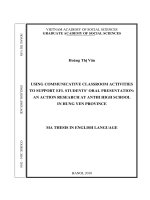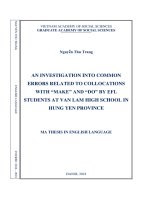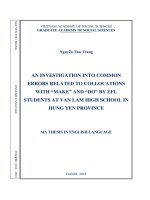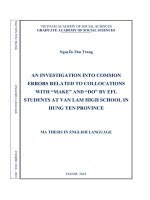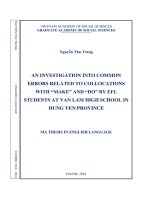Efl teachers and students perceptions and practices of teaching speaking at quang trung high school in binh dinh province
Bạn đang xem bản rút gọn của tài liệu. Xem và tải ngay bản đầy đủ của tài liệu tại đây (1.43 MB, 99 trang )
MINISTRY OF EDUCATION AND TRAINING
QUY NHON UNIVERSITY
DANG THI THANH THUY
EFL TEACHERS’ AND STUDENTS’ PERCEPTIONS
AND PRACTICES OF TEACHING SPEAKING
AT QUANG TRUNG HIGH SCHOOL
IN BINH DINH PROVINCE
Field: Theory and Methodology of English Language Teaching
Code: 8140111
Supervisor: Assoc. Prof. Dr. Nguyen Quang Ngoan
BỘ GIÁO DỤC VÀ ĐÀO TẠO
TRƯỜNG ĐẠI HỌC QUY NHƠN
ĐẶNG THỊ THANH THÚY
NHẬN THỨC VÀ THỰC TIỄN DẠY KỸ NĂNG NÓI
CỦA GIÁO VIÊN VÀ HỌC SINH
TRƯỜNG THPT QUANG TRUNG
TỈNH BÌNH ĐỊNH
Ngành: Lý luận và phương pháp dạy học bộ môn Tiếng Anh
Mã số: 8140111
Người hướng dẫn: PGS. TS. Nguyễn Quang Ngoạn
i
STATEMENT OF AUTHORSHIP
The thesis entitled “EFL Teachers’ and Students’ perceptions and
practices of teaching speaking at Quang Trung High School in Binh Dinh
Province” is conducted under the supervision of Assoc. Prof. Dr. Nguyen Quang
Ngoan, a lecturer at the School of Foreign Languages at Quy Nhon University.
I declare that the information reported in this study is the result of my work
and effort, except where due reference is made. The thesis has not been accepted for
any degree and is not concurrently submitted to any candidature for any degree or
diploma.
Binh Dinh, 2023
Dang Thi Thanh Thuy
ii
ACKNOWLEDGEMENT
This thesis work would not have been completed successfully without many
people's support, encouragement, and contributions. I take this opportunity to thank
them for their insightful thoughts, useful advice, and generosity of time. They have
enriched my knowledge and helped to make my graduate journey a special chapter
in my life.
First and foremost, I am grateful to my thesis supervisor, Assoc. Prof. Dr.
Nguyen Quang Ngoan, for his amazing supervision. His outstanding knowledge and
professional teaching-related expertise inspired me greatly during my academic life
at Quy Nhon University, and he opened new horizons for me in the field. I
appreciate his accommodating guidelines and suggestions, great patience, and
strong management skills in helping me overcome the challenges I faced as I
worked on my thesis. I feel fortunate to have had him support my work.
This study was made achievable by the presence of enthusiastic teachers
and students at Quang Trung High School in Binh Dinh Province, who devoted
their time to taking part in this research. I was thankful to all of them.
A special thanks goes to my dear friends Phung Thi Xuan Trang and Tran
Thi Lap. They not only encouraged me when I ran into difficulties with my thesis
but also gave me valuable insights into my thesis. I count myself fortunate to know
them.
Last but not least, I would like to express my deeply sincere gratitude to my
family and friends for their love, and encouragement, and for being with me along
my journey for the Master’s Degree.
iii
ABSTRACT
The main aim of this study was to investigate the perceptions and practices of
both teachers and students regarding teaching speaking skills at Quang Trung High
School in Binh Dinh Province. To achieve the purpose, a mixed methods approach
was conducted with 8 EFL teachers and 84 EFL students through questionnaires,
interviews, and classroom observation. Data from the study were collected through
two stages, including qualitative data and quantitative data. The findings disclosed
that although both teachers and students acknowledge the significance of speaking
skills, the extent of their awareness and concern varies considerably. While 100% of
participating teachers acknowledge the importance of this skill, only about 26% of
the surveyed students possess a clear understanding of the importance of speaking
skills. In practice, the results demonstrate a profound interconnection between these
two aspects. Teachers, always try to create opportunities and a favorable
environment to develop students' speaking skills. For students, while most students
finish the activities given by their teachers, their low frequency of regular practice
reveals their uncertainty and lack of confidence in their ability to express
themselves in English. Among various solutions, intensifying conversational,
speaking, and presentation activities in English classes is a notable approach to
enhancing students' speaking skills.
Keywords: EFL, perceptions, practices, solutions, teaching speaking
iv
TABLE OF CONTENTS
STATEMENT OF AUTHORSHIP ............................................................................ i
ACKNOWLEDGEMENT ......................................................................................... ii
ABSTRACT .............................................................................................................. iii
LIST OF ABBREVIATIONS .................................................................................. vii
LIST OF TABLES .................................................................................................. viii
LIST OF FIGURES................................................................................................... ix
CHAPTER 1. INTRODUCTION ............................................................................1
1.1. Research rationale.............................................................................................1
1.2. Research aim and objectives.............................................................................3
1.2.1. Aim..............................................................................................................3
1.2.2. Objectives ...................................................................................................3
1.3. Research questions............................................................................................3
1.4. Scope of the research ........................................................................................3
1.5. Research significance .......................................................................................4
1.6. Structure of the thesis ......................................................................................4
CHAPTER 2. LITERATURE REVIEW ................................................................5
2.1. Speaking............................................................................................................5
2.1.1. Definition of speaking ................................................................................5
2.1.2. Importance of speaking ..............................................................................6
2.1.3. Elements of Speaking.................................................................................6
2.1.4. Problems in speaking .................................................................................7
2.2. Teaching speaking ............................................................................................8
2.2.1. Principles in teaching speaking .................................................................8
2.2.2. Characteristics of successful speaking activity..........................................9
2.3. The roles of a teacher in speaking class .........................................................10
2.4. The role of learners in speaking class.............................................................10
2.5. Perception and practice of teaching speaking.................................................11
v
2.5.1. Perception ...............................................................................................11
2.5.2. Practice ...................................................................................................12
2.5.3 Relationship between perception and practice of teaching speaking .......13
2.6. Characteristics of high school learners ...........................................................14
2.7. Related studies on teaching speaking .............................................................15
2.8. Chapter Summary ...........................................................................................20
CHAPTER 3. METHODOLOGY .........................................................................21
3.1. Research approach ..........................................................................................21
3.2. Research participants ......................................................................................22
3.2.1. Teacher participants.................................................................................22
3.2.2. Student participants..................................................................................22
3.3. Research instruments ......................................................................................22
3.3.1. Questionnaire ...........................................................................................23
3.3.2. Interview ...................................................................................................23
3.3.3. Observation checklist ...............................................................................24
3.4. Research procedure.........................................................................................24
3.4.1. Pilot study.................................................................................................25
3.4.2. Data collection procedure........................................................................25
3.5. Data analysis ...................................................................................................26
3.5.1. Qualitative data analysis..........................................................................26
3.5.2. Quantitative data analysis........................................................................27
3.6. Ethical considerations .....................................................................................28
3.7. Summary.........................................................................................................29
CHAPTER 4. FINDINGS AND DISCUSSIONS .................................................30
4.1. Participants’ background information ............................................................30
4.2. Teachers’ and Students’ perceptions of teaching speaking ............................31
4.2.1. Teachers’ perceptions of speaking ...........................................................31
4.2.2. Students’ perceptions of teaching speaking .............................................35
4.2.3. The relationship between teachers’ and students’ perceptions of teaching
speaking skills.....................................................................................................39
vi
4.3. Teaching practice for English speaking skills ................................................40
4.3.1. Teachers' speaking instruction practice...................................................40
4.3.2. Students’ practice in speaking classes .....................................................42
4.3.3. The relationship between the practical teaching of speaking by teachers
and students' performance in speaking classes..................................................44
4.4. Solutions to teach speaking more effectively .................................................45
4.4.1. Solutions for teachers to teach speaking more effectively .......................45
4.4.2. Enhancing Effective Speaking Skills for Students ....................................48
4.4.3. Discussion of effective speaking teaching................................................50
4.5. Chapter summary............................................................................................52
CHAPTER 5. CONCLUSION ..............................................................................53
5.1. Summary.........................................................................................................53
5.2. Implications ....................................................................................................54
5.3. Limitations of the study ..................................................................................55
5.4. Recommendations for further studies .............................................................56
REFERENCES ........................................................................................................57
APPENDICES
vii
LIST OF ABBREVIATIONS
EFL: English as a Foreign Language
MOET: Ministry of Education and Training
QTHS: Quang Trung High School
SPSS: Statistical package for the social science
viii
LIST OF TABLES
Table 3.1: Reliability statistics for the questionnaire................................................28
Table 4.1. Teachers’ background demographics ......................................................30
Table 4.2. Students’ background demographics .......................................................31
Table 4.3. The importance of speaking skill in teaching English .............................32
Table 4.4. Perceptions of issues related to students ..................................................32
Table 4.5. Problems related to teachers’ teaching methods......................................34
Table 4.6. The importance of speaking skill .............................................................36
Table 4.7. Problems related to students ....................................................................37
Table 4.8. Problems related to teachers’ teaching methods......................................38
Table 4.9. The frequency of speaking activities .......................................................41
Table 4.10. The frequency of speaking activities .....................................................42
Table 4.11. The frequency of activities teachers commonly employed during
English lessons ..........................................................................................................43
Table 4.12. The effectiveness of speaking activities ................................................45
Table 4.13. The effectiveness of speaking activities ................................................48
ix
LIST OF FIGURES
Figure 2.1: The interaction of perception, cognition, and action..............................13
Figure 3.1. Data collection and analysis procedure ..................................................24
1
CHAPTER 1. INTRODUCTION
Chapter 1 presents the research rationale, research aim, and objectives,
research questions, research scope, research significance as well as the organization
of the thesis.
1.1. Research rationale
In many Asian contexts, English has become the preferred foreign language due
to globalization in different social, economic, cultural, and educational elements
(Nunan, 2003). English is now the most widely taught foreign language in Vietnam at
all educational levels as a result of English's growth as a global language (Hoang, 2011;
Nguyen, 2011; Pham, 2013). English is studied and taught across the nation, and there
is a need to encourage its study and improve the standard of English instruction.
English is currently a required subject at the secondary and tertiary education levels
after being introduced to young students in primary school. Despite having studied
English for a long time, students still struggle to grasp oral communication and reach
acceptable English proficiency levels. "Many school leavers cannot read simple texts in
English nor communicate with English-speaking people in some most common cases,"
is a common criticism, according to Le (2013, p. 66).
Since the National Foreign Language 2020 Project (NFLP/2020 Project) was
put into place by the Ministry of Education and Training in 2008 (MoET, 2008),
English instruction and learning in Vietnam have received increased attention. By
the year 2020, the majority of Vietnamese students should be able to communicate
effectively in a foreign language, particularly English, in their studies and at work.
The decision was then updated by Decision No. 2080/Q-TTg dated
December 22, 2017, which accepts the revised national strategy for studying and
teaching foreign languages in the years 2017 through 2025. The amended goal is to
significantly improve the standard of foreign language instruction and study at all
academic levels while promoting the use of foreign languages in social activities
and educational settings beginning in kindergarten (Prime Minister, 2017). For
students and teachers alike, these goals have made studying the English language at
2
all levels both hopeful and difficult. There is no exception when it comes to
teaching English to high school students. It is therefore unavoidable that new
textbooks, curricula, and methods for testing and assessment will be introduced.
The introduction of the new high school curriculum, which is being
implemented by Circular 32/2018/TT-BGDT dated December 16, 2019 (MOET,
2018), has resulted in promising English learning programs, which places greater
emphasis on the roles of teachers and students in the active learning process than
the previous pilot curriculum dated November 23, 2012 (MOET, 2012b).
The Vietnamese Ministry of Education and Training sent hundreds of EFL
teachers abroad for professional training to fulfill the objectives of the National
Project (Tran, 2013). To increase the caliber of EFL teaching and learning and
improve students' English communication abilities, they worked to implement novel
teaching techniques (Tran, 2013) and earlier English introduction in primary
schools. To give students the chance to converse with native English speakers and
establish real-world English-speaking situations in the classroom, schools and
colleges have hired native English TESOL (Teaching English to Speakers of Other
Languages) instructors. However, the bulk of English teachers are Vietnamese EFL
instructors, who serve as important stakeholders and agents. The impact of EFL
teachers' ideas on imparting English-speaking skills in their actual teaching
practices has not yet been investigated, despite even though taken training sessions
and embraced new teaching techniques.
Additionally, research on teachers' perceptions and practices has been made
clearer by the emerging tendency to connect theories and practices of language
learning. This is because it is thought that without some information with which to
operate, teachers are unable to practice effectively. To shed light on this strong and
complex interaction, there have been various research on teachers' perspectives and
practices. These studies have demonstrated that teachers' perceptions have a
significant influence on their instructional strategies (Chan, 2008; Farrell & Benisi,
2013; Gatbonton, 2008; Jerome & Stephen 2014; Shasavar & Jamalsadeh, 2015).
Furthermore, even though there has been a significant amount of research on
3
teaching speaking skill, and on EFL teachers' and students’ perceptions and
practices toward teaching speaking globally, in Asian contexts generally, and in
Vietnam specifically, their findings have not yet been fully generalized and no firm
conclusions have been drawn.
Due to the reasons outlined above as well as the fact that English is actually
taught and learned in Vietnam, this study was conducted with the following goals:
(1) to ascertain how high school EFL teachers perceive teaching speaking to high
school students, (2) to examine how they teach speaking at Quang Trung High
School (QTHS) in the framework of the new English teaching and learning, and (3)
to ascertain how students at QTHS perceive teaching speaking.
1.2. Research aim and objectives
1.2.1. Aim
This study aims to investigate teachers’ and students’ perceptions and
practices of teaching speaking at a high school in Binh Dinh Province.
1.2.2. Objectives
In order to achieve this aim, the following objectives are targeted:
- To understand how EFL teachers at QTHS perceive teaching speaking and
how they practice teaching the skill.
- To explore QTHS students’ perceptions of teaching speaking.
1.3. Research questions
With the aim and objectives stated above, the following research questions
are addressed:
1. What are EFL teachers’ perceptions and practices of teaching speaking?
2. What are EFL students’ perceptions of teaching speaking?
1.4. Scope of the research
Due to the limited time, the study mainly focuses on examining EFL
teachers’ and students’ perceptions and practices of teaching speaking. The study
was carried out at QTHS with the participation of 8 EFL teachers and 84 EFL
eleventh-grade students.
4
1.5. Research significance
This research is considered to be important for some reasons.
Theoretically, the present study provides necessary insights into the reality of
teaching speaking from local EFL teachers and EFL students’ perspectives. Its
findings, therefore, can act as a useful source of reference for future researchers
who are interested in the field of teaching speaking. It also helps enrich the theory
of teaching speaking.
Practically, the outcome of the research is expected to make a positive
contribution to English teachers’ perception and practices of teaching speaking skill
at QTHS, which is hoped to enhance the quality of speaking lessons. For students,
this research is expected to make students at QTHS aware of the importance of
speaking skill. Hopefully, it contributes to increasing students’ interest in the skill
so that they try to improve their English speaking ability.
1.6. Structure of the thesis
The report of the research is presented in five main chapters as follows:
Chapter 1 is Introduction. It presents the rationale, aims, and objectives,
research questions, the scope of the research, research significance, and the intended
structures of the thesis.
Chapter 2 is Literature Review. The chapter provides the theoretical
background on which the study is based and briefly presents a review of previous
studies related to this study.
Chapter 3 is Research Methodology. This chapter describes the research
design, research participants, research instruments, and research procedure.
Chapter 4 is Findings and Discussion. This chapter reports the results of the
study. The data are analyzed, shown in findings, and then thoroughly discussed.
Chapter 5 is Conclusion. First, it gives a summary of the results of the study.
It then discusses limitations of the study and makes suggestions for further
research.
5
CHAPTER 2. LITERATURE REVIEW
This chapter reviews the literature related to (1) speaking, teaching speaking
skill and their significance in language teaching and learning, (2) characteristics of
high school learners, and (3) related studies on teaching speaking.
2.1. Speaking
2.1.1. Definition of speaking
It gives individuals a platform to connect with others and communicate their
ideas, as well as their intents, hopes, and points of view. A "speaker" of a language
is sometimes referred to as someone who speaks it well. Speaking is the language
ability that is utilized the most in practically all situations. Torky (2006, p. 13)
claims that speaking is an expression of thought, ideas, and sentiment that makes
use of one's capacity for pronouncing words, grouping them into phrases or
sentences, and selecting words that are pertinent to the subject.
According to Lawtie (2004), speech is a necessary component of human
communication. It enables people to communicate with others around the world and
to express their views and opinions.
Bailey (2005) defines speaking as a productive aural/oral skill that consists
of producing systematic verbal utterances to convey meaning, which implies that
speaking is a useful skill for communicating ideas through speech.
Thornbury (2005) claims speaking is interactive, requiring the ability to
cooperate in the management of speaking turns. Cameron (2001) further describes
that speaking is the active expression of meaning via language with the purpose of
enabling others to understand it.
From the definitions provided above, it can be concluded that speaking is a
two-way process Howarth (2001) and Torky (2006). In other words, it is the
collaboration between two or more people in the shared context, and in the shared
time. It is a complicated interactive process between speakers and listeners, which
involves producing, decoding, and receiving messages using verbal and non-verbal
symbols. Speaking is, then, a technique that enables speakers to communicate their
6
developed and organized thoughts to listeners in a clear, efficient, and accurate way.
Speaking can be formal or informal.
2.1.2. Importance of speaking
A learner's success when learning a second language has been proven to
depend heavily on their ability to communicate verbally. Language learners
frequently assess their performance in language learning based on how much they
believe their spoken language ability has increased. According to Systems (2019),
students must understand how to communicate effectively with people of various
personality types. Additionally, Systems (2019) notes that students who lack
communication skills will not advance in their professional growth.
Speaking ability is said to be one of the qualities that language acquisition
emphasizes (Salambau et al., 2022). In order to communicate and transfer
knowledge or information from one person to another, this skill is necessary. For
example, a renowned academic, Nunan (1999), has long demonstrated that speaking
fluently in a language is the usual measure of linguistic competency (p. 225).
Similarly, Brown (2001), believes that communicative ability is the most crucial
component of language learning. It is essential to speak English, especially with the
language's increasing significance in a variety of contexts, including job interviews,
tourism, and commerce (Crystal, 1997, Mattarima & Hamdan, 2011; Muamaroh,
2013). As stated by Kuśnierek (2015), speaking would also promote social
connection in every civilization. Students must therefore develop speaking abilities
to learn a language.
2.1.3. Elements of Speaking
Harmer (2001) asserts that there are components to speaking ability. These
factors clarify that speaking fluently requires both the capacity to comprehend
information and language "on the spot" as well as an understanding of linguistic
aspects. The following items are classified as linguistic features.
The first factor is connected speech. In order to employ linked speech, we must
be able to alter our speech sounds. Assimilation, elision, connecting, modification, and
weakening of sounds can all be used to change their characteristics.
7
The second factor is expressive devices. Every English speaker alters the
volume and pace of some utterances, places emphasis on certain portions of the
utterances, and uses various physical and non-verbal (paralinguistic) techniques to
convey their feelings (particularly during face-to-face interactions).
The third factor is lexis and grammar. Several popular lexical phrases are
often used in spontaneous speech, particularly while performing certain language
functions.
Negotiation language is the next factor. Negotiator language, which is used
to ask for clarification and illustrate the organization of what pupils are saying, is
advantageous for effective speaking.
In addition to the linguistic characteristics already mentioned, other crucial
components are mental/social processing, language processing, interacting with
others, and information processing. Those aspects discussed above must be taken
into account if one is to become a successful communicator.
2.1.4. Problems in speaking
Some of the problems with speaking skill that students can come across
when learning are inhibition, lack of topical knowledge, low participation, and
mother-tongue use (Nguyen & Tran, 2015).
The first problem that students face in class is inhibition. They may
experience speech inhibition when they want to speak out in class. They worry
about making errors and are afraid of being judged. They are embarrassed by how
much the other pupils are focusing on them. According to Littlewood (2007), a
language classroom can also cause pupils to feel nervous and inhibited.
The second proposition is that there is nothing to say. According to Baker
and Westrup (2003), learners find it very challenging to respond when their teachers
ask them to describe something in a foreign language because they are unsure of
what to say, what vocabulary to use, or how to correctly utilize grammar. Some
students find that speaking in front of other students requires them to have
something to say, thus if they don't have anything to say, they will likely be more
reserved and refrain from speaking during class.
8
Another issue that hinders students from speaking is their low or uneven
participation. According to Ur (2012), a huge class with little time allotted for each
student may also result in low involvement from the students.
The frequent use of mother tongue and anxiety are the next problems. While
Harmer (2007) believes that using one's mother tongue may help with learning,
including speaking, Ur (2012) believes that using one's mother tongue may do more
harm than good.
Additionally, environmental factor is one of the barriers preventing
Vietnamese students from speaking. According to some academics, less favorable
setting makes it difficult for students to practice or improve English communication
skills outside of the classroom (Muamaroh, 2013).
2.2. Teaching speaking
2.2.1. Principles in teaching speaking
Hinkel (2017) states that imparting speaking skills in a second language
entails assisting language students in developing a certain set of interpersonal and
communication abilities. The development of speech-processing, discourse
organization, and oral production abilities, as well as correct grammar, a robust
vocabulary, accurate pronunciation, and information sequencing are all
requirements for learning a second language (Hinkel, 2017).
According to Al Hosni (2014), "The focus of teaching speaking is to improve
the oral production of students" (p. 22). While speaking instruction has long been
neglected, English teachers tend to teach speaking through drill repetition or
discourse memorization. The present period, however, requires that speaking
instruction enhance students' communication abilities since only in this way can
students learn and communicate how to uphold proper social and cultural values
suited to every communicative circumstance.
To improve students' academic performance and prospects, teaching
speaking while learning a second language is essentially the same as imparting the
language in a tangible and useful way. Instead of expecting students to memorize
something, language teachers place a lot of emphasis on teaching speaking because
9
with careful attention, teachers may support students' development of speaking
abilities.
Teaching speaking in an EFL context differs from those in ESL and English
in a native language context. To teach speaking in an EFL setting, Bailey (2003, pp.
47–66) identifies five key elements. First, understanding the differences between
the contexts for learning a second language and a foreign language. Second,
allowing students to practice their accuracy and fluency. Third, giving students the
chance to converse by using group or pair projects and limiting teacher time. Next,
creating speaking assignments that need meaning negotiation. Last, creating in-class
exercises where students receive guidance and practice in both transactional and
interactional speaking.
2.2.2. Characteristics of successful speaking activity
According to Ur (1996, p. 201), some traits of effective speaking exercises
include students talking a lot, participants being evenly distributed, motivation
being high, and language being of an appropriate quality.
In speaking class, students need to talk a lot. Students discuss as much as
they can throughout the time allotted for the activity. This may seem apparent, yet
frequently the teacher's discourse or pauses take up the majority of the time.
For a successful speaking activity, all students are evenly distributed.
Discussions in class are not dominated by a small number of engaged students. It
implies that participation is divided reasonably equitably and that each student has
an opportunity to speak.
Besides, students’ high motivation is also an important factor resulting in an
efficient speaking class. Students are often driven to speak out because they are
passionate about the subject, have something original to add, or want to help the
class complete a task.
One more quality of effective speaking activity is students’ language is of an
acceptable level. Students communicate in meaningful ways that are simple to
understand and have a passable degree of correctness. If they lack communication
skills, they will be unable to understand the speaker's use of English, and do not



